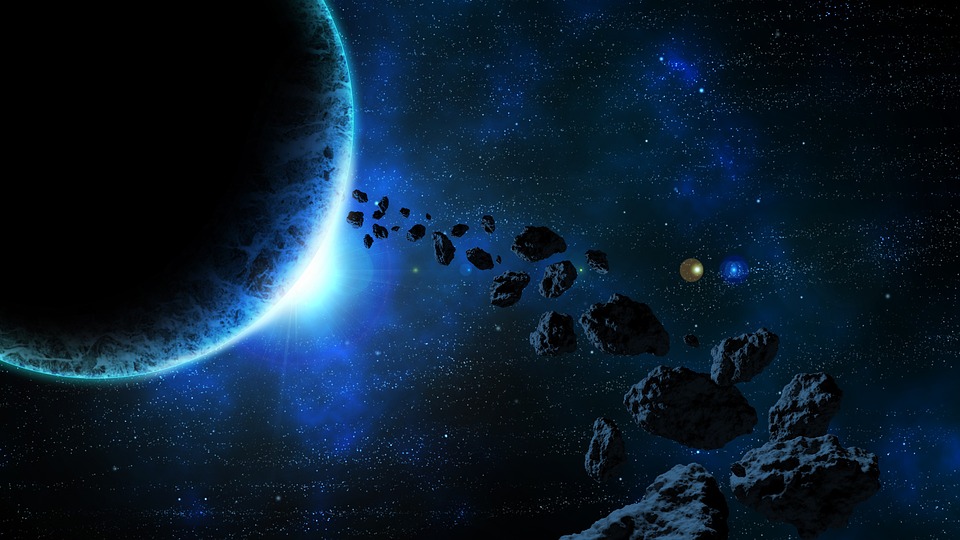As far as asteroids are concerned, we only know of them when they decide to approach the planet, or at least be on their way towards Earth. However, one particular asteroid that NASA plans on visiting seems to have a small moon orbiting around it.
It is not every day that asteroids become destinations but rather celestial objects to avoid or study. But Express reports that NASA’s Lucy mission, set for takeoff in 2021, will launch a probe to visit the Trojan asteroids, which are located in Jupiter’s orbit. However, the researchers from the Southwest Research Institute or SwRI, who are also leading the mission, discovered that one of the asteroids has a small natural satellite or moon in its orbit.
The asteroid, known as Eurybates, has an orbital period of 12 years and is one of the bigger Trojan asteroids measuring 63 kilometers in diameter. It makes sense that this particular asteroid would have a satellite orbiting around it due to its size. According to Hal Levison, the principal investigator for SwRI, Eurybates would have been the likely choice in having a satellite compared to the rest of the asteroids under the Trojan cluster. Levison explained that Eurybates is believed to be the biggest remnant of a collision that happened billions of years ago.
Running through simulations, it found that asteroid collisions such as what happened to Eurybates were what made the clusters like Trojan asteroids have small satellites. The satellite orbiting Eurybates, on the other hand, proved difficult to find.
Meanwhile, it is widely believed that asteroid collisions on Earth were what caused the extinction of the dinosaurs millions of years ago. A new report reveals a breakthrough in what exactly caused the extinction of the species.
One of the other possible reasons as to why the dinosaurs went extinct was due to volcanic eruptions that occurred at the time. However, some researchers still believe that asteroid collisions were what caused the fall of the dinosaurs during the Cretaceous-Paleogene era. A new study found that volcanoes were not a big factor in their extinction, and researchers from Yale University claimed that the Deccan traps that resulted from those volcanic eruptions already happened before the Cretaceous-Paleogene period. Furthermore, they claimed that while the traps were responsible for climate change, it was an asteroid impact that was the main culprit.



 Trump Administration to Launch Autism Initiatives Targeting Acetaminophen Use and New Treatment Options
Trump Administration to Launch Autism Initiatives Targeting Acetaminophen Use and New Treatment Options  Neuren Pharmaceuticals Surges on U.S. Patent Win for Rare Disorder Drug
Neuren Pharmaceuticals Surges on U.S. Patent Win for Rare Disorder Drug  Trump and Merck KGaA Partner to Slash IVF Drug Costs and Expand Fertility Coverage
Trump and Merck KGaA Partner to Slash IVF Drug Costs and Expand Fertility Coverage  Astronomers have discovered another puzzling interstellar object − this third one is big, bright and fast
Astronomers have discovered another puzzling interstellar object − this third one is big, bright and fast  SpaceX Starship Test Flight Reaches New Heights but Ends in Setback
SpaceX Starship Test Flight Reaches New Heights but Ends in Setback  NASA Cuts Boeing Starliner Missions as SpaceX Pulls Ahead
NASA Cuts Boeing Starliner Missions as SpaceX Pulls Ahead  Lost in space: MethaneSat failed just as NZ was to take over mission control – here’s what we need to know now
Lost in space: MethaneSat failed just as NZ was to take over mission control – here’s what we need to know now  Trump Signs Executive Order to Boost AI Research in Childhood Cancer
Trump Signs Executive Order to Boost AI Research in Childhood Cancer  SpaceX’s Starship Completes 11th Test Flight, Paving Way for Moon and Mars Missions
SpaceX’s Starship Completes 11th Test Flight, Paving Way for Moon and Mars Missions  Lab-grown meat: you may find it icky, but it could drive forward medical research
Lab-grown meat: you may find it icky, but it could drive forward medical research  Ancient Mars may have had a carbon cycle − a new study suggests the red planet may have once been warmer, wetter and more favorable for life
Ancient Mars may have had a carbon cycle − a new study suggests the red planet may have once been warmer, wetter and more favorable for life  Blue Origin’s New Glenn Achieves Breakthrough Success With First NASA Mission
Blue Origin’s New Glenn Achieves Breakthrough Success With First NASA Mission  Kennedy Sets September Deadline to Uncover Autism Causes Amid Controversy
Kennedy Sets September Deadline to Uncover Autism Causes Amid Controversy  Cogent Biosciences Soars 120% on Breakthrough Phase 3 Results for Bezuclastinib in GIST Treatment
Cogent Biosciences Soars 120% on Breakthrough Phase 3 Results for Bezuclastinib in GIST Treatment 































